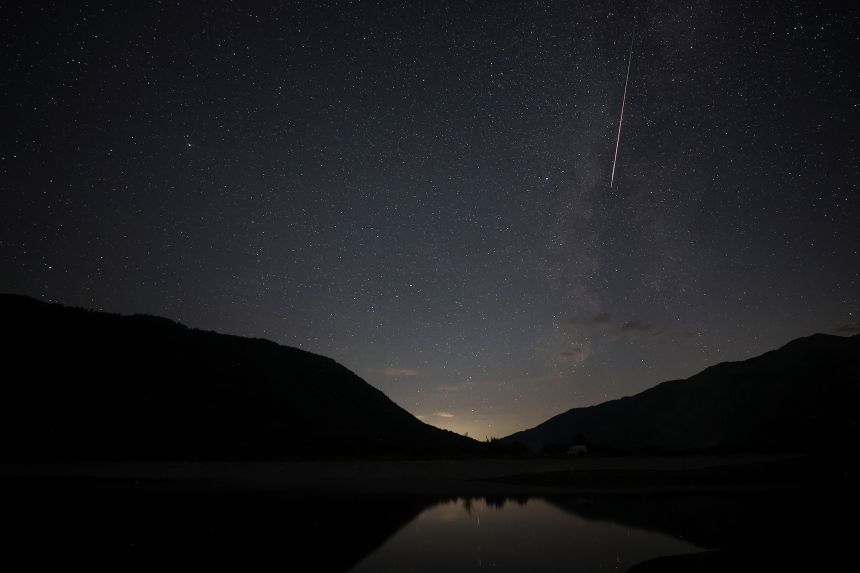Sky-gazers may get a good chance to see fireballs streak across the night sky this week. Two meteor showers — the Alpha Capricornids and Southern Delta Aquariids — will reach their peak and another is ramping up.
The Alpha Capricornids meteor shower, which is best known for producing very bright meteors called fireballs that may look like shooting stars, will be most visible at 1 a.m. ET Wednesday, according to Robert Lunsford, fireball report coordinator for the American Meteor Society. Its radiant — the point at which the meteor streaks seem to originate — is in the Capricorn constellation.
The Alpha Capricornids are visible all over the world but are usually best seen from the Southern Hemisphere, in places such as Australia and Africa, according to Bill Cooke, the lead for NASA’s Meteoroid Environments Office. These meteors are expected to appear at a rate of three to five per hour. If you are viewing from the Northern Hemisphere, keep your eyes low along the southern sky to catch a glimpse.
If you stay up later, you’ll be able to see the Southern Delta Aquariids reach peak activity at 3 a.m. ET on Wednesday, said Lunsford. The Southern Delta Aquariids, which also are most visible in the Southern Hemisphere, make for a stronger shower than the Capricornids; people located in parts of the Northern Hemisphere such as the US can expect to view up to 10 to 15 meteors per hour, while those in the Southern Hemisphere may see 20 to 25 per hour.
The Aquariids appear to stream from the southern part of the Aquarius constellation, which is around 40 degrees east of the Capricorn constellation, according to Lunsford: “They’re going to kind of do a battle, shooting back and forth at each other.”
Both showers will be visible through August 13, though there is some disagreement about the date on which their peaks will occur. While experts at the American Meteor Society say peak activity will occur Tuesday night into early Wednesday morning, those at NASA say it will happen Wednesday night going into Thursday.
“The time of a meteor shower peak is not constant from year-to-year. It can vary by plus or minus a day or two,” Cooke said.
But missing the peak, according to Lunsford, is nothing to fret about. “It’s not a real sharp peak …You can go out (on) the 31st or the 29th and see pretty much the same activity.”
For the best viewing, avoid areas with bright lights and objects that could obscure your view of the sky, such as tall trees or buildings. Picking a spot with a higher altitude, like a mountain or hill, may make it easier to spot these showers.

According to Cook, having multiple meteor showers occur at the same time is a common phenomenon. “For example, during the Perseids, you have the remnants of the Southern Delta Aquariids going on,” he said.
Right now, the Alpha Capricornids, the Southern Delta Aquariids and Perseids are all active and while the Perseids is not at its peak , you might still see some of its meteors this week. There’s also the possibility of seeing 10 to 12 meteors that aren’t associated with any of these showers, according to Lunsford.
Both the Alpha Capricornids and Southern Delta Aquariids become visible annually when Earth passes through debris fields left by two Jupiter-family comets: 169P/NEAT (Alpha Capricornids) and P2008/Y12 (Southern Delta Aquariids). Cook also noted that, each year, “we’re passing closer to the core of the material that produces (the Alpha Capricornids) shower and in 200 years, it’ll be the strongest shower that’s visible from Earth. It’ll actually produce more than 1,000 (meteor streaks) an hour, which is quite a bit stronger than it is now.”
For those interested in contributing to astronomers’ understanding of meteors, this week presents the perfect opportunity to count how many meteors you see in the night sky and report them to places like the American Meteor Society.
Here are the other meteor showers to anticipate in 2025 and their peak dates, according to the American Meteor Society and EarthSky.
-
Perseids: August 12-13
-
Draconids: October 8-9
-
Orionids: October 22-23
-
Southern Taurids: November 3-4
-
Northern Taurids: November 8-9
-
Leonids: November 16-17
-
Geminids: December 12-13
-
Ursids: December 21-22
Look out for five more full moons this year, with supermoons occurring in October, November and December.
Here’s the list of full moons remaining in 2025, according to the Farmers’ Almanac:
-
August 9: Sturgeon moon
-
September 7: Corn moon
-
October 6: Harvest moon
-
November 5: Beaver moon
-
December 4: Cold moon
Lunar and solar eclipses in 2025
Two eclipse events will occur as summer ends.
A total lunar eclipse will be visible in Europe, Asia, Australia, Africa, parts of eastern South America, Alaska and Antarctica on September 7 and 8, according to Time and Date.
A lunar eclipse occurs when Earth passes exactly between the sun and the moon, throwing the latter into shadow and making it appear darker or dimmed.
When the moon sits in the darkest part of Earth’s shadow, the sun’s rays bend around Earth and refract light on the moon’s surface, which gives it a reddish hue, according to London’s Natural History Museum. Some people call the result a “blood moon.”
Two weeks after the total lunar eclipse, a partial solar eclipse will be visible in parts of Australia, the Atlantic, the Pacific and Antarctica on September 21.
Solar eclipses occur when the moon moves between the sun and Earth, blocking part of the sun’s surface from view, according to NASA. This creates a crescent shape — as if something took a “bite” out of the sun.
Sign up for CNN’s Wonder Theory science newsletter. Explore the universe with news on fascinating discoveries, scientific advancements and more.

